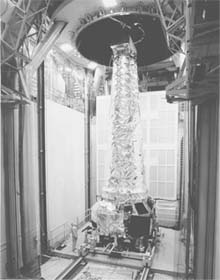No final frontier
 the us National Aeronautics and Space Administration ( nasa ) plans to launch its biggest space telescope that will be named Chandra (after the India-born scientist S Chandrasekhar) in July 1999. Its specific objective will be "to unravel the mysteries of the evolution of the Universe'. The sheer size and complexity of the Universe have never deterred humans from thinking about it, though there are more questions than answers. Are all stars and galaxies static or are they in motion in respect to the Earth? If they are in motion, are they moving towards us or away from us?
the us National Aeronautics and Space Administration ( nasa ) plans to launch its biggest space telescope that will be named Chandra (after the India-born scientist S Chandrasekhar) in July 1999. Its specific objective will be "to unravel the mysteries of the evolution of the Universe'. The sheer size and complexity of the Universe have never deterred humans from thinking about it, though there are more questions than answers. Are all stars and galaxies static or are they in motion in respect to the Earth? If they are in motion, are they moving towards us or away from us?
As we know, the force of gravity pervades the entire Universe. Therefore, it is natural to expect that different types of structures must be moving under gravitational influence. Though these events can be observed in our solar system, they only give us a picture of our neighbourhood. The nagging question, however, remains as to what is the state of the whole Universe?
In 1929, us astronomer Edwin Hubble found that all galaxies are moving away from the Earth. Moreover, galaxies far away have a higher velocity, meaning that the Universe is expanding. The rate of this cosmic expansion is known as Hubble constant H . It is natural to ask whether we know the final state of the Universe? Will it expand forever? Is there a limit to its expansion? What are the other states through which the Universe may pass? The answers to most of these questions remain elusive.
To unravel these questions, scientists are also trying to decide the state of the Universe with the help of other observational techniques. Astronomers are using distant supernovae to study the nature of the Universe's expansion. Supernovae are massive exploding stars, and are classified in two types: Ia and II . Supernova type II is a supergiant star that burns up its nuclear fuel, blowing up its own material and energy. It releases energy in varying forms like radio waves, optical waves, neutrinos and kinetic energy of debris. The type Ia supernova is a white dwarf star that undergoes thermonuclear explosions (a white dwarf star is a dim and dense stellar cinder that mostly contains carbon and oxygen). In this scenario, a white dwarf continuously sucks gas from the companion star and accretes mass until it reaches the Chandrasekhar limit (that is 1.4 times the mass of the Sun). At this stage' pressure becomes very intense and the carbon at its core starts heating. This leads to a thermonuclear explosion, which is one of the most powerful and brightest explosions in the Universe. In fact such explosions take place so ferociously that they can outshine entire galaxies for a few weeks.
Two teams of astronomers are observing the supernovae Ia to study the expansion of the Universe. One is led by Saul Perlmutter of Lawrence Berkeley National Laboratory, University of California, Berkeley. Brian Schmidt leads the other team from Mt Stromlo and Siding Spring Observatory of Australia. First of all, the astronomers spot distant supernovae from thousands of galaxies with the help of a four-metre telescope at the Cerrotulolo Inter-American Observatory in Chile. Identifying supernovae is not easy. Very sophisticated computer programmes and skilled eyes are needed. "It is as much art as science,' says Gerson Goldhaber, physicist and Permutter's colleague. Scrutinising each object is essential
Related Content
- Evaluation for Agenda 2030: providing evidence on progress and sustainability
- The final frontier: Israel signs agreement with UN space group
- Myanmar's Pending Ceasefire Jeopardized by Skirmishes Over Illegal Logging
- Delhi nod for NFR project
- Indo-Bangla rail link by 2 yrs
- Arctic Nations Eye Future Of World's Last Frontier
